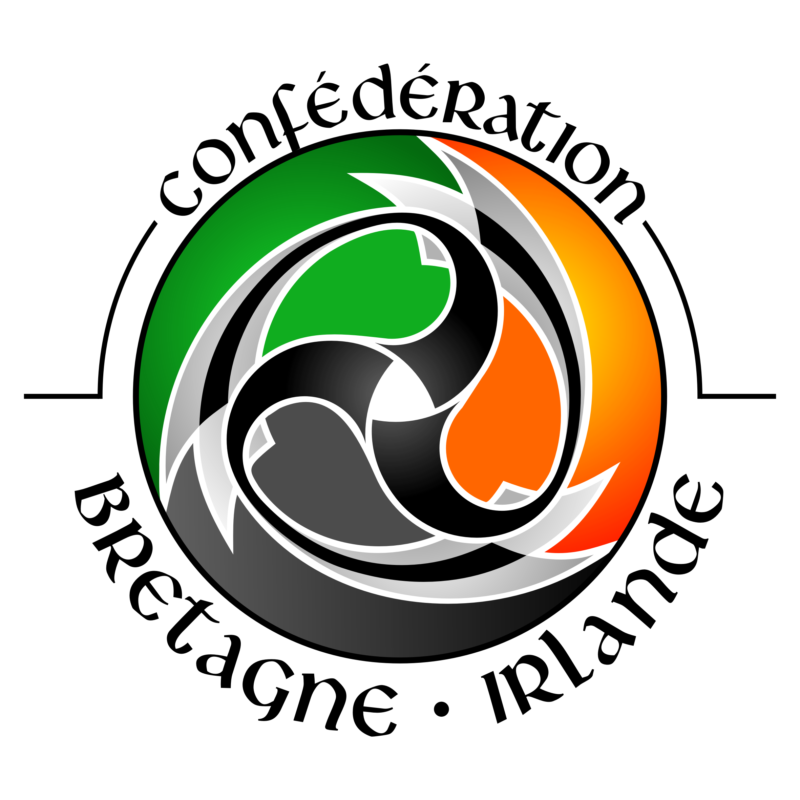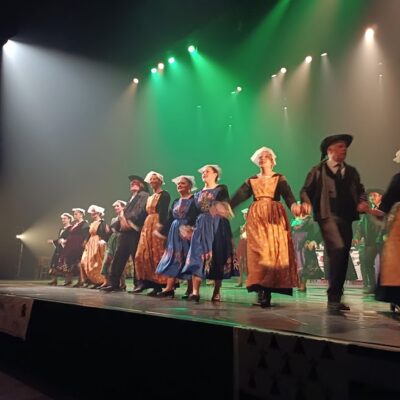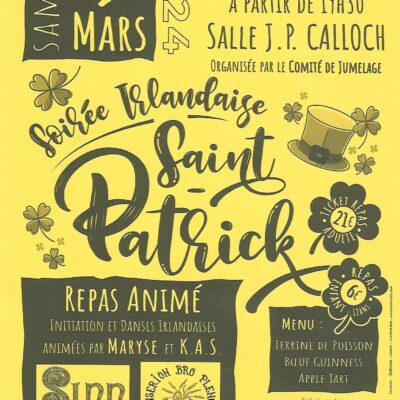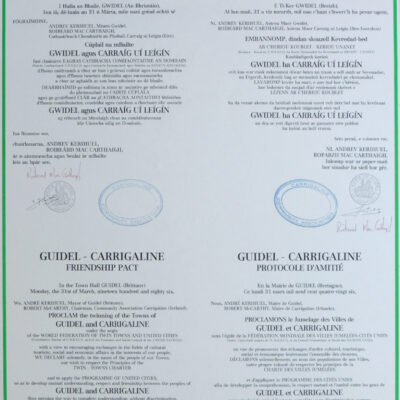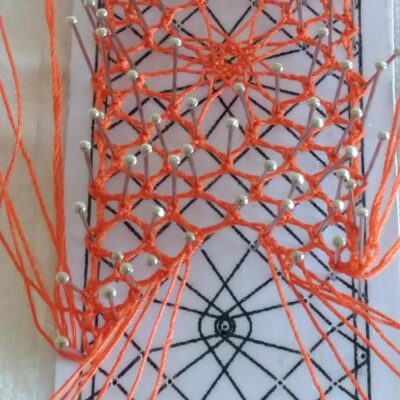Twinning in Brittany has been an institution since 1964 !
Today, we’re noticing that the word « twinning » seems outdated, obsolete and even outmoded. It seems to be reserved for an aging population. But is this vision correct? What is twinning? Who does it involve, and why? Why are young people turning away from this opportunity to visit a friendly country? How can a resident get in touch with such an association? And, more generally, does twinning still have a future in Brittany?
Twinning: a commitment between two communities
Formalizing a twinning arrangement under any name is first and foremost a commitment.
- – Charter
- – Covenant
- – Pledge
- – Cooperation
- – Friendship pact, etc.
The aim is to facilitate the realization of projects between two communes. It incorporates a long-term relationship of trust, transcending political ideals and focusing solely on the interests of the community.
Even though the charter is structured, it can still be modified, and changes can be made by simple amendment. Indeed, over the years, projects and their implementation may evolve.
The text must be submitted to the municipal council for approval. The pledge is then signed at a public meeting. In this way, the signatories commit to each other. The signing takes place in both communes.
If it had to be done, a deliberation by the municipal council is sufficient to break the pledge.

Below is an example of a twinning pledge:
A different administrative structure in France and Ireland
Initially, twinning schemes were run by local authorities. They soon delegated management of the twinning to an association, which took all the necessary steps to set up and monitor the actions to be carried out. They could also apply for funding in their own name.
As things stand today, some municipalities are clearly withdrawing from these associations because they see no benefit for their communities. Fortunately, this rarely happens.
While in France we have the possibility of creating an independent structure capable of bringing in funding for projects, the situation is different for our Irish counterparts. In fact, there is no such thing as a 1901-type association. What’s more, the administrative structure as we know it is completely different in Ireland.
How do I join a twinning association in Brittany?
As we explained above, twinning is created between two towns. So the logical first step is to contact your local town hall and ask if there is a twinning association with a town in Ireland or elsewhere. At this stage, the town hall will give you the contact details of the person in charge of the association.
Our website brittany-ireland.com lists a number of twinning arrangements with the relevant Irish town. A non-exhaustive map makes for easy reading.
In September, many associations will take part in the annual forum, giving you the chance to meet the active members who will be there to share and will end up convincing you.
Once you’ve joined, you become a volunteer, contributing your personality, motivation and knowledge to the life of the association
Is twinning outdated and obsolete?
Is the lack of commitment from young people and aging membership a sign that twinning has become obsolete?
Despite a certain ageing, twinning associations in Brittany are still very present and relatively active. Not all of them have joined the Brittany-Ireland Confederation, but there are over fifty twinning arrangements between Brittany and Ireland to date.
The ageing of twinning members
For more than ten years, we have been observing that members of twinning and other non-twinning associations are getting older. Commitment is waning when most of these people have been involved for decades.
The difficult situation of 2020-2021 has left its mark, forcing new habits that run counter to the association system. As a result, new members have themselves adopted different lifestyle choices. The inflationary crisis we’re experiencing is also putting the brakes on travel to association meetings.
Do we absolutely have to perpetuate an association’s membership?
The question arises, but we can’t give a clear answer. Indeed, to be structured and efficient, we are used to having a certain stability in our boards of administrators and offices. And it’s in these bodies that renewal doesn’t take place. So where does this leave us ? Could mandates be limited in time? Is it possible to modify the associative structure by introducing co-managers? Or maybe the new system doesn’t yet exist and has yet to be discovered…

How is a twinning committee financed?
Like all 1901 associations in France, funding comes from a number of sources:
- Membership fees
- Association activities during the year (tombola, evening events, English courses, etc.)
- Municipal subsidies
- Exceptional grants for one-off actions
- Departmental, regional and European grants
- Partnerships with companies
- sponsoring
Pooling of strengths makes financing easier when it comes to preparing applications for departmental and/or regional grants. To this end, the federations and the confederation provide support for financial applications to the relevant bodies.
The basis of twinning: a project and actions
As members at the last general meeting of the Morbihan federation so aptly suggested, our twinning projects need to be linked to very specific actions. The days of organized trips to Ireland or to introduce our Irish friends to our beautiful region are no longer sufficient to develop exchanges. Nowadays, anyone can travel as they wish, and sometimes can obtain far more attractive rates than by going through the twinning committees.
So let’s think differently and be innovative in our projects!

Young people seem far removed from associations
The leitmotif in the associative world remains the same: where are the young people? But beyond this observation, let’s ask ourselves a few questions:
- What have we done to ensure that twinning is a part of youth activities in our towns?
- Do we offer games and one-off events during festivals such as St. Patrick’s Day, Halloween or Brittany Day?
- Do we carry out collective actions between twinning and the music school, sports clubs, literary clubs, or all the youth associations during the school year?
What concrete contribution does a twinning committee make to the youth of its town? Some committees have realized that it’s necessary to get involved in the community first and foremost. And, once recognition has been obtained, it’s then time to set up a project with the Irish town.

Why join a twinning association in Brittany?
As someone who has been involved in this field for over 25 years, I invite young and old alike to join us, because the more people we have, the more ideas for exchanges, cooperation and aid can develop.
Twinning is first and foremost an association that brings together the community’s vital forces. It enables each of us to take a different look at our civic involvement. What a joy to have been able to take a group of young musicians to Ireland, where they rubbed shoulders with seasoned musicians in pub sessions! And they come back with such bright smiles that the organizers can only congratulate themselves.
Or a young girl who wants to work in Ireland for a season, or an Irish student who wants to learn more French.
Of course, members will always be just as happy to take part in trips to the green Erin as they are to welcome their twins into their homes to deepen and develop a lasting friendship. One doesn’t preclude the other. And the fact remains that the friendship between the Bretons and the Irish is a loyal one.
Twinning in Brittany … or how to renew and act for the community?
The current situation allows us to remain optimistic about the evolution and development of twinning committees. Proof of this lies in the constant requests from towns wishing to twin with Ireland.
But also, it has this attraction of Ireland following the Brexit and the administrative difficulty of setting up school or student trips.
In addition to all these arguments, the internet is a facilitating tool for creating exchanges and managing the development of projects that engage all parties concerned.
Let’s be inventive, creative and enthusiastic, and reach out to these young people full of new ideas without preconceptions! And then we’ll be in for some pleasant surprises.
Twinning is above all popular
When something is popular, it means it has the approval of the greatest number of people. Twinning can only be successful if it directly affects the town’s population. This is achieved through the actions carried out by the association throughout the year.
Without this movement towards others, we’re left with a group of people who enjoy each other’s company, and who remain locked into habits of alternating travel between the two towns.
So let’s continue to cultivate close ties with the local population, by opening up our trips to people involved in twinning and its activities throughout the year. Let’s be a driving force in integrating other sports, cultural and economic associations into bipartite actions.
Ireland: a different way of working
Today, our Irish counterparts are looking at twinning in Brittany, and despite a desire to federate, they don’t have the status of associations. Their municipal structures operate differently from ours. For example, they don’t have halls like we do. As a result, it’s more difficult to prepare projects and bring them to fruition without structural support.
But, unlike France, they have a much more efficient and accessible transport network. They criticize us for this aspect, which is becoming an obstacle to setting up travel projects.
Perhaps one of the steps we could take would be to look into the possibility of creating a European associative statute. This would give twinning the same opportunities in all countries. Utopia or possibility?
« The link that unites, in a spirit of equality and reciprocity, entire populations from two or more different countries, with a view to promoting contact between people, and the exchange of ideas, techniques and products. It is an instrument of popular culture and international civic education, and cannot be diverted from its purpose for personal, partisan or political ends ».
(Twinned Towns Charter – 1957).
credit : http://jumelages-nouvelle-aquitaine.eu/quest-ce-quun-jumelage/
Author’s note: « I wrote this text because all my experience of twinning with Ireland since 1998 gives me enough objectivity to talk about it without too much emotion. I was president of the Pluvigner-Cahersiveen – County Kerry twinning committee for over 10 years. I was president of the Morbihan federation for 10 years and today I’m secretary of the Brittany-Ireland confederation. I’ve had some wonderful adventures, and I’ve benefited enormously from them.
This site had no article on twinning as such, and that’s why I wanted to talk to you about this subject, which is particularly close to my heart.
We’re approaching sixty years of twinning, and I believe we can renew ourselves and bring new adventures to the people of our towns.
Sylvie RUFET
Translation : Steve and Brigitte (Larmor-Plage/Youghal)
